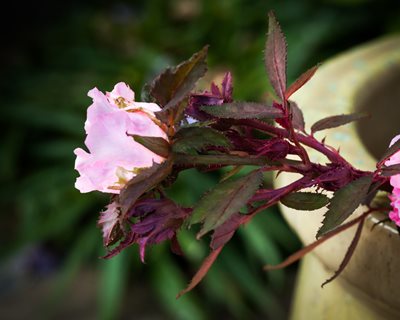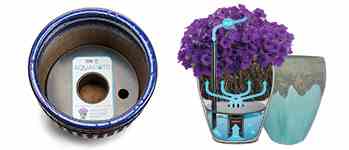How to Treat & Prevent Rose Rosette Disease
Protect your rose plants from this devastating disease
A symptom of rose rosette disease, brush-like clusters of shoots emerging from the same point on the plant. Photo by Valerie Johnson / Shutterstock.com
Roses are one of the most widely grown garden plants, revered for their delicate flowers and sweetly perfumed scent. For all of their unparalleled beauty, there are many different rose diseases that can affect plants.
Rose rosette disease is a serious problem for rose gardeners, and is more prevalent in certain regions of the U.S. This virus, which is transmitted by mites, causes stunted growth, deformities, and eventual death of the plant. Though there is no cure for rose rosette disease, there are ways to protect the rose bushes in your garden. Find out more about this disease and what you can do about it.
On this page:- What is rose rosette disease?
- How does rose rosette affect rose plants?
- What are the signs of rose rosette?
- How do you get rid of rose rosette?
- How do you prevent rose rosette disease?
- Frequently asked questions
WHAT IS ROSE ROSETTE DISEASE?
Rose rosette disease (RRD), a relatively new problem specific to roses, is caused by the rose rosette virus (RRV). First identified in the 1940s, the disease was only recently discovered to be caused by a virus. This condition causes roses to grow strange looking deformities on rose stems, leaves, and flowers.
The most common host plant for rose rosette disease is the wild multiflora rose (Rosa multiflora), which has naturalized and become an invasive plant in many parts of the U.S. The highest incidence of rose rosette disease occurs in the southern and Mid-Atlantic regions, but it can also be found in the Midwest and Northeast. Multiflora rose is found in most states, so there is potential for the disease to occur in nearly any part of the U.S.
Rose rosette virus is spread by eriophyid mites (Phyllocoptes fructiphilus), which are wingless and move by crawling. These microscopic insects, which are too tiny to see with the naked eye, travel on wind currents, spreading the virus in the wild as well as in home gardens, where it has become a problem for cultivated roses. The mites can be transmitted on humans and animals, on clothing, shoes, and garden tools. The virus can also be spread through rose grafting.
HOW DOES ROSE ROSETTE AFFECT ROSE PLANTS?
Some of the effects of rose rosette disease include:
- Weakened plants, with reduced winter hardiness
- Disfigured bushes that are no longer attractive
- Increased susceptibility to other pests and diseases
- Eventual death of infected plants
WHAT ARE THE SIGNS OF ROSE ROSETTE?

Excessive thorns from rose rosette disease. Photo by Valerie Johnson / Shutterstock.com
Plants with rose rosette disease may show just one or a few symptoms, or sometimes all of them. Initially, only a small part of the plant may be affected, with symptoms more likely to show up during the early or mid growing season. Possible symptoms include:
- Elongated or distorted new growth
- Bright red new growth that doesn’t fade to green like normal growth does
- Distorted or discolored foliage and flowers
- Branch dieback
- Thickened stems that are larger in diameter than older growth
- Excessive thorniness on branches and stems
- Loss of flowers or leaves
The most telltale sign of rose rosette disease is the development of brush-like clusters of shoots that emerge from the same point on the plant. This growth can occur randomly across the entire plant. Leaves are often distorted or stunted, with red or yellow coloring. Affected flowers may be discolored, stunted, or blighted, often failing to open. This abnormal growth is referred to as rose rosette, for which the disease is named, and is also known as witches’ broom.
HOW DO YOU GET RID OF ROSE ROSETTE?
The first step in dealing with rose rosette disease it to confirm that you have it. Take photos and share them with your local nursery or extension office. You can also have a trained professional examine a portion of the diseased plant. Cut off a small part of the affected area and place in a sealed plastic bag for transport to a local extension office.
If your rose is confirmed to have the disease, remove the entire plant immediately, including the root ball. There is no cure for RRV/RRD, and it can’t be reliably controlled by pruning out the affected parts. Place a garbage bag over the entire plant and close it off before digging up, putting the rootball in a separate bag if necessary. While the virus will be throughout the plant, the mites (if still present) will be on the upper portion of the plant and can be spread if not enclosed first. Dispose in the trash to avoid spreading the disease. Monitor other nearby rose plants for any symptoms.

Photo by Valerie Johnson / Shutterstock.com
HOW DO YOU PREVENT ROSE ROSETTE DISEASE?
There is no effective rose rosette disease treatment available to home gardeners, so the next best option is prevention. Though the disease is not entirely preventable, there are a number of steps you can take for controlling the mites to lessen the chance of plants becoming infected.
- Eliminate host plants. If there are multiflora roses on or near your property, have them removed. Work with your community or local government to eliminate wild host plants in public landscapes and natural areas. If you take out roses yourself, disinfect tools and wash your hands, clothing, and gloves before working around other plants to prevent the transmission of mites to your garden roses.
- Prune and deadhead roses. Mites overwinter on flower buds and seed heads. Prune these off of roses in late winter or early spring and dispose in the trash. During the growing season, remove spent blooms where mites often accumulate.
- Provide shelter. Eriophyid mites are spread primarily through wind currents. Plant your roses in a spot that is sheltered from prevailing winds, which will help reduce exposure to airborne mites.
- Allow space. Plant rose bushes in different parts of your yard to help prevent the transmission of rose rosette disease from plant to plant.
- Create mixed plantings. Place tall non-rose plants between rose bushes to act as a barrier, which will slow or halt the spread of disease.
- Keep rose bushes healthy. Stressed plants are more likely to become diseased. Promote healthy roses by watering during dry spells, fertilizing regularly, and controlling other pests and diseases.
- Avoid leaf blowers. Stirring up the air in your yard with a leaf blower can increase the chance of transmitting mites to your roses.
FREQUENTLY ASKED QUESTIONS
Can you save a rose with rose rosette disease?
This disease is almost always fatal, though it can take 2 to 4 growing seasons for infected roses to die back completely. It’s best to remove an infected plant as quickly as possible to avoid the spread of disease to other roses.
Can you replant roses after rosette disease?
Though the virus can’t survive in the soil, any roots that remain after an infected plant is removed can still contain the virus. It’s recommended to wait several years for remaining roots to die completely before planting another rose in the same spot.
Can humans get rose rosette disease?
Though rose rosette disease can be transmitted by people through getting the mites on skin, clothing, and shoes, there is no risk of illness or disease to humans.
ONLINE COURSE:
MASTER PESTS, DISEASES, AND WEEDS
How to prevent, identify, and manage garden pests, plant diseases, and weeds.
Learn how to keep your garden healthy from Joe Lamp'l, one of the country's most recognized and trusted gardeners in this self-paced online course. Lifetime access, $47
RELATED:
How to Prune Roses
How to Get Rid of Powdery Mildew
Black Spot on Roses





